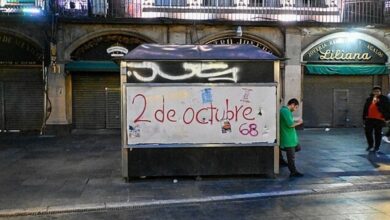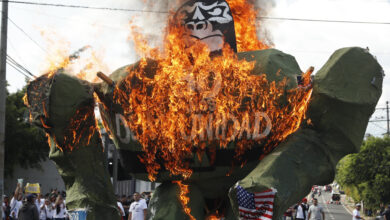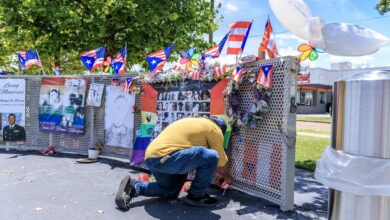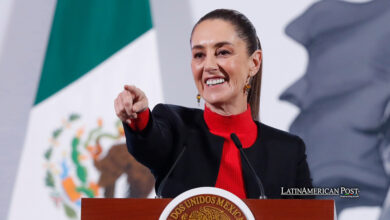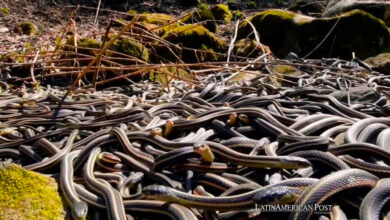Mexico’s Tlatelolco Massacre Remembered as Protests Reignite

This week’s commemoration of the 1968 Tlatelolco massacre turned violent in Mexico City, reigniting debates about who is genuinely responsible for the tragic event. Fifty-six years later, the wounds remain open, with unanswered questions hanging over one of Mexico’s darkest days.
Clashes Continue Decades After Event
On the 56th anniversary of the Tlatelolco massacre, thousands of demonstrators marched through Mexico City, honoring the memory of the hundreds of students who were killed on October 2, 1968. The peaceful march at the Plaza de las Tres Culturas ended with clashes between police and a group of protesters as they arrived at the Zócalo, the capital’s main square. This year’s march mirrored the frustrations and anger of previous commemorations, with a mixture of mourning and defiance fueling the protestors’ actions.
While most of the demonstrators moved peacefully from Tlatelolco to the Zócalo, a radical faction known as ‘Bloque Negro,’ began vandalizing businesses and clashing with police as they attempted to deface the headquarters of the Government of Mexico City. The situation escalated as protesters hurled stones, fireworks, and incendiary devices, prompting police officers to respond with fire extinguishers to disperse the crowd. According to Mexico City’s Secretary of Citizen Security, Pablo Vázquez Camacho, several officers were injured during the confrontation.
The Tlatelolco massacre is an event forever etched in Mexican history, and each year, the march to commemorate it stirs emotions ranging from sorrow to rage. The violence during the protests reflects a broader sense of unresolved justice and the continued demand for accountability. The memory of the massacre still haunts the nation, with many Mexicans wondering if the whole truth behind the killings will ever be known.
The Tlatelolco Massacre: Mexico’s Tragic 1968
To understand the significance of the Tlatelolco protest, one must look back to October 2, 1968—a date that marked a brutal turning point in Mexico’s history. In the months leading up to that day, student protests had erupted across Mexico City. Students from the National Autonomous University of Mexico (UNAM), the National Polytechnic Institute (IPN), and other schools organized to demand democratic reforms, an end to government repression, and increased freedom of expression. The students’ calls for change were met with increasing hostility from the government of President Gustavo Díaz Ordaz.
What began as a peaceful student movement quickly escalated into a violent confrontation with the state. The Mexican government, fearing a disruption to the upcoming 1968 Olympic Games set to be held in Mexico City, sought to crush the movement. On the night of October 2, thousands of students gathered in the Plaza de las Tres Culturas in Tlatelolco to listen to speeches and peacefully demonstrate. Without warning, military and police forces surrounded the plaza, and gunmen—believed to be government snipers—opened fire on the crowd.
The massacre that followed left hundreds of students dead, with some estimates suggesting the death toll reached as high as 500. The exact number of casualties remains disputed to this day, as the government immediately implemented a cover-up, arresting thousands of demonstrators and controlling the narrative through the media. President Díaz Ordaz’s administration blamed communist agitators and extremists for inciting the violence, but eyewitnesses and evidence suggest that the Mexican government orchestrated the bloodshed to silence the student movement.
The massacre was not only a moment of profound tragedy but also a turning point in Mexican society. It shattered the illusion of a benevolent government and exposed the brutal lengths to which the ruling Institutional Revolutionary Party (PRI) would go to maintain control. The events of Tlatelolco marked the beginning of Mexico’s Dirty War, a period of intense political repression and violence that lasted well into the 1980s.
Who Is Responsible? Decades of Denial and Cover-Up
One of the most pressing questions surrounding the Tlatelolco massacre is who bears ultimate responsibility for the bloodshed. In the immediate aftermath, the Mexican government placed the blame squarely on the protesters, claiming that armed students had fired on the military, provoking the attack. However, over the years, evidence has emerged that suggests a far more sinister plot involving government forces.
Declassified documents from both the Mexican and U.S. governments have shed light on the role played by the Mexican military and police, as well as the involvement of the CIA and the U.S. government in supporting the Díaz Ordaz regime during a period of Cold War paranoia. These documents reveal that the Mexican government had been monitoring the student movement closely and had prepared for a violent confrontation long before the massacre occurred.
One key piece of evidence is the involvement of the Olympia Battalion, a secret government force created to ensure the security of the 1968 Olympics. Members of this battalion were seen in the plaza on the night of the massacre, wearing white gloves to distinguish themselves from civilians. Eyewitnesses and researchers have since argued that these operatives fired the first shots, deliberately provoking the military to retaliate against the crowd. This strategy, it is believed, was designed to justify the government’s violent crackdown on the student movement.
Despite mounting evidence pointing to the government’s role in orchestrating the massacre, those responsible have evaded mainly accountability. President Díaz Ordaz and his successor, Luis Echeverría, both maintained their innocence, with Echeverría even being appointed as ambassador to Spain in 1977, despite his alleged involvement in the killings. In 2006, Echeverría was briefly placed under house arrest on charges of genocide, but the case was ultimately dismissed for lack of evidence.
To this day, no one has been convicted for their role in the Tlatelolco massacre, leaving a lingering sense of injustice for the families of the victims. The question of who is responsible remains unanswered, with many Mexicans feeling that the government has failed to reckon with its violent past. The recent public apology from the administration of President Claudia Sheinbaum represents a step towards acknowledging the state’s guilt, but for many, it is too little, too late.
Memory, Protest, and Accountability
The Tlatelolco massacre has cast a long shadow over Mexico’s political landscape, shaping the country’s relationship with protest, dissent, and state power. Each year, the anniversary of the massacre serves as a reminder of the dangers of unchecked authority and the need for vigilance in protecting civil liberties. For survivors and the families of those killed, the march is both a form of protest and a call for justice that has been denied for over five decades.
The massacre also remains a potent symbol of the struggle for democracy in Mexico. In the years following the massacre, Mexico underwent significant political changes, culminating in the election of Vicente Fox in 2000, which ended 71 years of PRI rule. However, the legacy of Tlatelolco continues to resonate, as recent protests against government corruption, violence, and impunity echo the demands of the students who gathered in the plaza in 1968.
Today, the Tlatelolco massacre is often compared to other infamous state-sponsored acts of violence, such as the Tiananmen Square massacre in China or the Kent State shootings in the United States. In each case, the government’s use of lethal force against its citizens shattered the public’s trust in the state and sparked long-lasting movements for reform.
For Mexico, the Tlatelolco massacre remains an open wound. As the recent protest shows, the anger and frustration felt by those who seek justice have not diminished. The violence that erupted during this year’s commemoration is a reminder that the struggle for accountability continues and that the scars of 1968 have not yet healed.
Also read: Five Key Elements of Mexico’s Controversial Judicial Reform Proposal
The public apology issued by the Mexican government this week is a step towards addressing the wrongs of the past, but it is not enough. True justice for the victims of Tlatelolco will require a complete reckoning with the events of that night, including a transparent investigation into who gave the orders to shoot and why. Only then can Mexico move forward from the shadow of its violent past.

